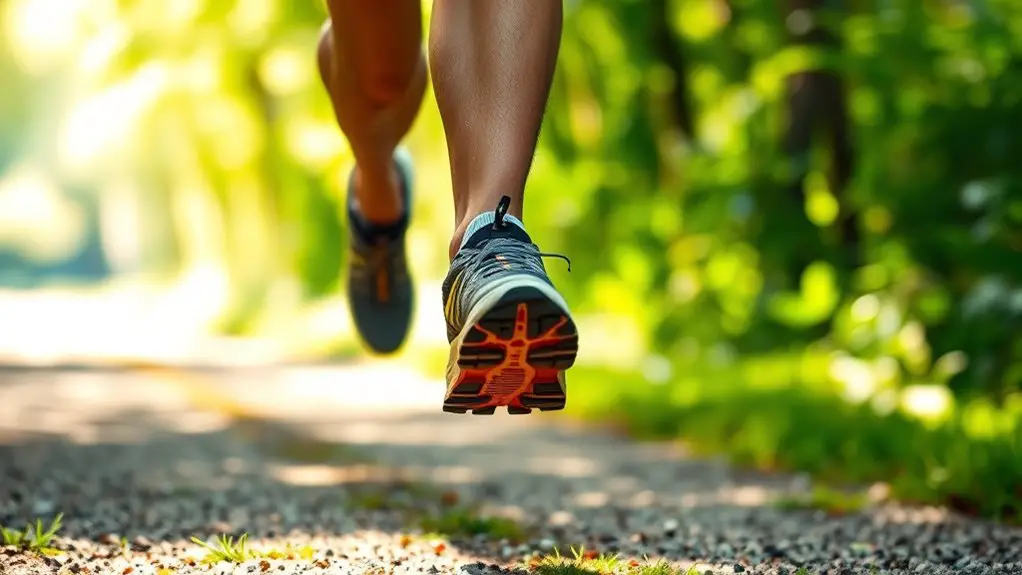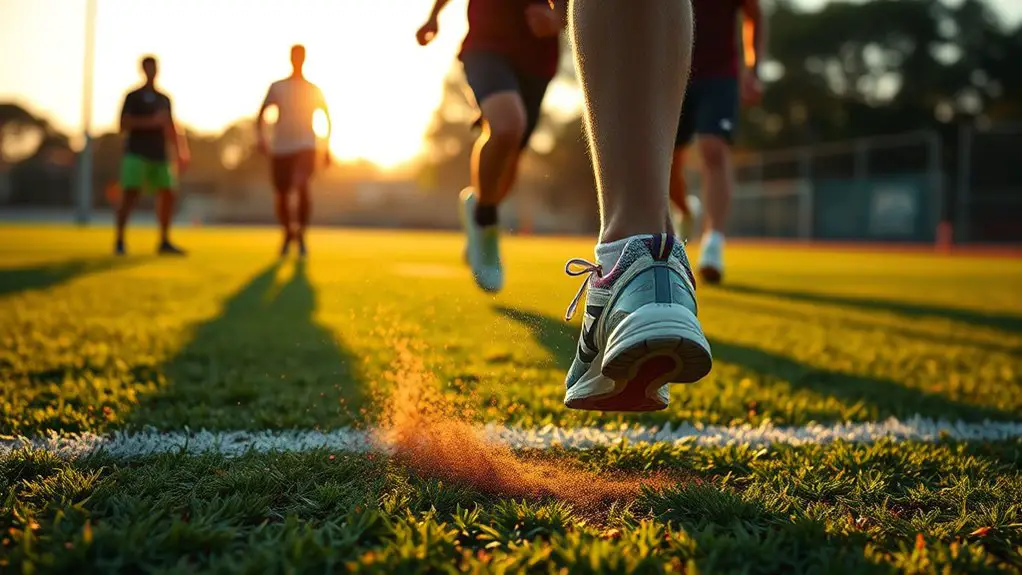To improve your cadence for better endurance, start by evaluating your current rhythm and setting realistic goals based on your fitness level. Incorporate cadence drills and use metronome training to develop a consistent beat. Proper footwear is vital for comfort and performance, while balanced nutrition supports energy levels. Finally, track your progress regularly and celebrate small achievements to stay motivated. Discover effective strategies to further enhance your cadence and overall performance.
Understanding Cadence and Its Importance
Cadence, often referred to as the rhythm of your movement, plays an essential role in endurance activities like running and cycling. Understanding the cadence basics can empower you to find your flow, releasing a sense of freedom in your workouts. It's all about how many steps or pedal strokes you take per minute, and finding that sweet spot can enhance your performance and enjoyment.
The cadence benefits are significant. A higher cadence can reduce fatigue, improve efficiency, and even lessen the risk of injury. By maintaining a consistent rhythm, you'll feel lighter on your feet, allowing you to explore new trails or roads with confidence. This rhythm not only propels you forward but also connects you with the exhilarating pace of your journey. To truly maximize your performance, consider incorporating high-intensity interval training to boost your overall endurance and cadence. So, embrace the beat of your movement and let your cadence guide you towards greater endurance and the freedom you crave.
Assessing Your Current Cadence
How do you know if your cadence is suitable for your endurance activities? It starts with a cadence analysis, where you can measure your current rhythm against performance metrics. By evaluating your cadence, you can reveal your potential and experience the freedom of improved endurance. Staying hydrated is crucial, as hydration supports optimal performance during your training sessions.
Here's a simple table to help you gauge your cadence:
| Activity | Suitable Cadence (spm) | Your Current Cadence (spm) |
|---|---|---|
| Running | 170-180 | |
| Cycling | 80-100 | |
| Swimming | 50-70 | |
| Rowing | 24-30 | |
| Walking | 100-130 |
Fill in your current cadence next to each activity to see where you stand. This evaluation can guide your training and help you find that sweet spot for ideal endurance. Embrace the journey to a better cadence!
Setting Realistic Cadence Goals
As you begin to set cadence goals, it's important to take into account your current fitness level and the specific demands of your chosen activity. Start by identifying your cadence benchmarks—these serve as reference points for your progress. If you're new to endurance training, don't aim for elite levels right away; instead, focus on achievable increments.
Make realistic adjustments based on how your body responds. For instance, if you currently maintain a cadence of 160 steps per minute, try increasing it by 5% over a few weeks. This gradual approach not only keeps you motivated but also helps prevent injury. Incorporating rest days into your training can further enhance your recovery and performance. Listen to your body; if you feel too fatigued, it's okay to slow down and reassess your goals. Remember, the journey to improved cadence is about finding freedom in your movement, so allow yourself the space to grow at your own pace.
Techniques to Increase Cadence
Boost your cadence with practical techniques that make a real difference. You can implement cadence drills and metronome training to elevate your rhythm and enhance your endurance. By integrating these methods into your routine, you'll find yourself running smoother and faster.
Here's a quick overview of effective techniques:
| Technique | Description |
|---|---|
| Cadence Drills | Short bursts of increased steps to build muscle memory. |
| Metronome Training | Use a metronome app to maintain a steady beat while you run. |
| High-Knees Exercise | Engage your core and elevate knees to increase cadence naturally. |
Incorporate these strategies into your workouts, and embrace the freedom of flowing through your runs with newfound efficiency. You'll notice a significant boost in your overall performance and enjoyment. Additionally, focusing on acceleration techniques can further enhance your overall running efficiency and speed.
The Role of Proper Footwear
Choosing the right shoes is essential for your running performance. A proper fit, along with adequate cushioning and support, can make a significant difference in your comfort and endurance. Let's explore how the right footwear can enhance your cadence and overall running experience. Additionally, understanding your foot type can help you select shoes that provide the necessary support and cushioning for your unique needs.
Shoe Fit Importance
When it comes to enhancing your endurance, the right shoe fit plays an essential role in your performance and comfort. Finding your perfect fit means considering shoe size, foot shape, and arch support. A spacious toe box allows your toes to move freely, while heel drop influences your stride.
| Aspect | Importance |
|---|---|
| Shoe Size | Guarantees proper fit and comfort |
| Arch Support | Supports natural foot position |
| Material Quality | Affects breathability and durability |
| Lacing Technique | Aids in weight distribution |
Good footwear can also prevent injuries, helping you enjoy the freedom of movement. Prioritize quality shoes that embrace your feet, and you'll feel the difference on your runs!
Cushioning and Support
Although many runners focus on shoe fit, cushioning and support are equally essential for enhancing endurance. The right cushion types can make all the difference, absorbing impact and reducing fatigue during long runs. You'll want to explore options like foam, gel, or air-based cushions, each offering unique benefits to keep your feet feeling light and free.
Support levels are just as important; you need a shoe that provides stability without restricting your natural movement. Look for shoes that match your arch type and running style, ensuring you maintain your rhythm. By prioritizing both cushioning and support, you'll not only improve your cadence but also enjoy a more liberating and comfortable running experience. Choose wisely, and let your feet soar!
Incorporating Cadence Drills Into Your Training
To improve your running efficiency, incorporating cadence drills into your training is key. You'll want to explore essential techniques and consider various tools for measurement to track your progress. By focusing on these elements, you can make significant strides in enhancing your endurance. Additionally, incorporating long runs into your training schedule can further enhance your overall performance and endurance levels.
Essential Cadence Techniques
Incorporating cadence drills into your training can greatly enhance your endurance and overall performance. To maximize your results, focus on cadence breathing and rhythm techniques that align with your natural flow. Here are some essential techniques to reflect upon:
| Technique | Description |
|---|---|
| Short Strides | Shorten your steps for quicker turnover. |
| Metronome Practice | Use a metronome to maintain a steady beat. |
| Cadence Breathing | Synchronize your breath with your foot strikes. |
| Hill Repeats | Run uphill to engage your cadence more intensely. |
Tools for Measurement
Measuring your cadence accurately is essential for integrating cadence drills effectively into your training regimen. Luckily, you've got plenty of tools at your disposal. Cadence apps are a fantastic option; they can track your steps and provide real-time feedback, making adjustments easy. These apps often come with features that analyze your performance over time, helping you pinpoint areas for improvement.
Fitness trackers are another great choice. They not only monitor your heart rate, but they also offer cadence metrics, giving you a thorough view of your training. By incorporating these tools, you'll gain the freedom to customize your workouts and maximize your endurance. Embrace technology, and watch your cadence—and overall performance—improve!
Monitoring Your Progress
Tracking your progress is essential for improving your cadence and overall endurance. By keeping tabs on your performance, you'll gain insights that can help you fine-tune your training. Use tools like apps or wearable devices for effective progress tracking. These can provide valuable data on your stride rate and distance, allowing for real-time performance analysis.
Set specific, achievable goals, and regularly review your stats. This'll help you stay motivated and focused on your journey toward freedom in your movement. Celebrate small victories, whether it's increasing your cadence or running longer distances. Wearable fitness trackers enhance your ability to monitor progress and make informed adjustments to your training.
Don't forget to mix up your training routine, as variety can provide fresh challenges and boost your progress. Remember, it's about enjoying the journey as much as reaching your destination. So, embrace every step, and let the data guide you toward a more liberated, enduring you. Keep pushing, and watch your cadence soar!
The Impact of Terrain and Environment
While you might focus on your cadence and endurance during training, the terrain and environment play significant roles in shaping your performance. Terrain challenges, like hills or rocky paths, can force you to adjust your rhythm. When running uphill, for instance, you may find yourself naturally slowing down. Embracing this change can actually enhance your overall endurance rather than hinder it. Additionally, maintaining proper hydration levels is crucial for sustaining energy during these varying conditions. Environmental factors, such as temperature and wind, also impact your cadence. Hot, humid days might zap your energy, while a brisk breeze can feel invigorating. It's important to adapt your approach based on these conditions.
Nutrition and Recovery for Endurance
Adapting to varying terrains and weather conditions is essential, but to truly enhance your endurance, nutrition and recovery are just as important. You'll want to focus on macronutrient balance, incorporating protein, carbs, and fats to fuel your body effectively. Hydration strategies are vital—don't forget those electrolytes!
Protein is essential for muscle repair after your workouts, so make sure to include it in your recovery plan.
Here's a quick overview of fueling and recovery:
| Pre Workout Snacks | Post Workout Meals | Supplement Options |
|---|---|---|
| Banana & almond butter | Grilled chicken & quinoa | BCAAs |
| Oatmeal & berries | Salmon & sweet potatoes | Protein powder |
| Greek yogurt & honey | Veggie stir-fry | Electrolyte drinks |
| Energy bars | Smoothie with spinach | Multivitamins |
Meal timing and nutrient timing can make a big difference. Use recovery techniques like stretching and foam rolling to help your muscles bounce back. With the right fueling strategies, you'll find the freedom to go further!
Staying Motivated on Your Cadence Journey
Staying motivated on your cadence journey is all about setting realistic goals and celebrating small victories along the way. You'll find that breaking your larger goals into manageable steps makes the process more enjoyable. Remember, each little win is a step forward, so take the time to acknowledge your progress!
Set Realistic Goals
Setting realistic goals is essential for maintaining motivation on your cadence journey. When you engage in effective goal setting, you empower yourself to make meaningful progress without feeling overwhelmed. Break your journey into achievable milestones that align with your unique pace and lifestyle. Instead of aiming for an unrealistic cadence right away, focus on gradually increasing your rhythm over time. This way, you're more likely to stay committed and enjoy the process. Remember, every small improvement counts. It's about finding freedom in your journey, not just the destination. As you hit those milestones, you'll build confidence and desire to keep pushing forward. Embrace the journey, and let your goals fuel your passion for better endurance.
Celebrate Small Victories
Recognizing and celebrating small victories can greatly enhance your motivation throughout your cadence journey. By acknowledging each step forward, you'll find the freedom to stay committed. Here are some ways to celebrate milestones:
- Track Your Progress: Keep a journal to note improvements in your cadence.
- Reward Yourself: Treat yourself to something special when you reach a goal.
- Share Achievements: Tell friends or family about your progress for positive reinforcement.
- Visual Reminders: Use sticky notes or a vision board to highlight your achievements.
These small gestures create a powerful sense of accomplishment, fueling your desire to keep pushing forward. Remember, every incremental win is a step towards greater endurance and freedom. Celebrate them!
Frequently Asked Questions
How Does Cadence Affect My Overall Performance in Endurance Sports?
Cadence plays an essential role in your overall performance in endurance sports. By maintaining an ideal cadence, you can enhance efficiency, reduce fatigue, and improve your speed. These cadence benefits translate to better performance metrics, allowing you to push your limits while feeling more in control. When you find that sweet spot, you'll experience a sense of freedom in your movements, letting you enjoy the ride or run even more.
Can Cadence Be Improved Without Increasing My Running Speed?
Absolutely, you can improve your cadence without cranking up your speed! In fact, studies show that runners with a higher cadence, around 180 steps per minute, often experience reduced injury rates. By incorporating cadence drills into your routine, you can enhance your running form. Focus on shorter, quicker strides, which allows for a more fluid movement. You'll feel that freedom as your body adapts, making each run more enjoyable and efficient!
What Technology Can Help Me Track My Cadence Effectively?
To track your cadence effectively, you've got some great options. Cadence apps, available on smartphones, can provide real-time feedback, making it easy to monitor your strides. Alternatively, wearable devices like smartwatches or fitness trackers offer built-in cadence metrics, keeping you informed without interrupting your flow. With these tools, you can enjoy your runs while staying connected to your performance, giving you the freedom to improve at your own pace.
Is There an Ideal Cadence for Different Types of Terrain?
When you're dancing through the hills, cadence shifts like the rhythm of a song. On steep climbs, you'll want a slower, powerful beat, while trail variations call for a quicker, lighter step to navigate twists and turns. Embrace the freedom of adjusting your pace; it's your journey. Aim for 150-180 steps per minute on flat surfaces, and let your body flow with the terrain, finding your perfect cadence in nature's embrace.
How Do Weather Conditions Impact My Cadence and Endurance?
Weather conditions can really affect your cadence and endurance. When it's hot, you might find yourself slowing down due to temperature effects, needing more breaks. In cold weather, your muscles may tighten, making it harder to maintain a steady rhythm. Adapting to these weather variations is key; learn to adjust your pace and breathing. Embracing these changes can enhance your freedom to enjoy your runs, regardless of what Mother Nature throws your way.




